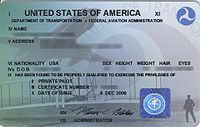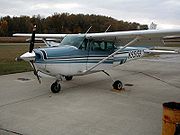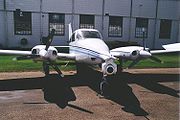
Private Pilot License
Encyclopedia

Aircraft
An aircraft is a vehicle that is able to fly by gaining support from the air, or, in general, the atmosphere of a planet. An aircraft counters the force of gravity by using either static lift or by using the dynamic lift of an airfoil, or in a few cases the downward thrust from jet engines.Although...
privately (not for pay). The requirements to obtain the license are determined by the International Civil Aviation Authority (ICAO), but the actual implementation varies widely from country to country. According to the ICAO, it is obtained by successfully completing a course with at least 40 hours (45 in the UK and Spain) of flight time, passing 7 written exams, completing an extensive solo cross country flight (minimum cumulative solo flight time is 10 hours), and successfully demonstrating flying skills to an examiner during a flight test or checkride (including an oral exam). In the US pilots can be trained under Title 14 of federal code part 141 which allows them to apply for their certificate in as little as 35 hours. However, most pilots require 60–70 hours of flight time to complete training. The minimum age for a Private Pilot Certificate is 16 for Balloons and Gliders, 17 for powered flight (Airplanes, Helicopters, and Gyroplanes). Pilots can begin training at any age and can solo balloons and gliders at age 14, powered aircraft at age 16.
Issuing Authorities
A PPL may be issued by the FAAFederal Aviation Administration
The Federal Aviation Administration is the national aviation authority of the United States. An agency of the United States Department of Transportation, it has authority to regulate and oversee all aspects of civil aviation in the U.S...
for American certification
Pilot certification in the United States
Pilot certification in the United States is required for an individual to act as a pilot of an aircraft. It is regulated by the Federal Aviation Administration , a branch of the Department of Transportation...
, the JAA
Joint Aviation Authorities
The Joint Aviation Authorities, or JAA, was an associated body of the ECAC representing the civil aviation regulatory authorities of a number of European States who had agreed to co-operate in developing and implementing common safety regulatory standards and procedures...
for European certification, the CASA
Civil Aviation Safety Authority
The Civil Aviation Safety Authority is the Australian national aviation authority , the government statutory authority responsible for the regulation of civil aviation.-History:...
for Australian certification, or Transport Canada
Transport Canada
Transport Canada is the department within the government of Canada which is responsible for developing regulations, policies and services of transportation in Canada. It is part of the Transportation, Infrastructure and Communities portfolio...
for Canadian certification. Each organization has different requirements. Insurance rates for private pilots are lower than those of sport or recreational pilots, because private pilots are trained to a higher degree.
Categories & Classes
Different types of private licenses are issued for the major categories of aircraft. It is possible to obtain a license for, e.g., rotorcraft or airships, without first — or ever — obtaining a rating for a fixed-wing aircraft. However, limitations, such as "Limited to Hot Air Balloons with Airborne Heater" for Hot Air Balloon ratings (as opposed to a gas balloon) will appear on the license under the "Limitations" portion of the certificate. The classes listed on the license further define which aircraft of a category the license holder is qualified to operate.Aircraft


Classes are:
- Airplane
- Rotorcraft
- Glider
- Lighter than air
- Powered lift
- Powered parachute
- Weight shift control
Categories are:
- Normal
- Utility
- Acrobatic.
Airmen
With respect to the certification of airmenCategories are:
- Single engine land
- Single engine sea
- Multi-engine land
- Multi-engine sea
Ratings
A license will contain a number of sub-qualifications or ratings. These specify in more detail the actual privileges of the license, including the types of aircraft that can be flown, whether flight under Instrument Flight RulesInstrument flight rules
Instrument flight rules are one of two sets of regulations governing all aspects of civil aviation aircraft operations; the other are visual flight rules ....
and at night is allowed, and whether instructing and examining of trainee pilots is authorized. Ratings include Single and/or Multi-Engine Aircraft, Land or Seaplane, each of which require a checkride with an approved examiner.
Additional Endorsements
In addition, a number of endorsements are available for specific skills (additional requirements apply). Endorsements only require instruction and a Flight Instructor's endorsement, they do not require any flight test with an FAA representative.Sec. 61.31 Federal Aviation Regulations endorsements required to act as Pilot in Command (PIC) are:
- TailwheelConventional landing gearthumb|The [[Piper PA-18|Piper Super Cub]] is a popular taildragger aircraft.thumb|right|A [[Cessna 150]] converted to taildragger configuration by installation of an after-market modification kit....
- Complex airplaneComplex airplaneA complex airplane is defined by the United States Federal Aviation Administration as an aircraft that has all of:*A retractable landing gear...
- aircraft with a variable pitch propellerControllable pitch propellerA controllable pitch propeller or variable pitch propeller is a type of propeller with blades that can be rotated around their long axis to change their pitch...
, flaps, and retractable landing gear - High-performance (more than 200 horsepower)
- Pressurized aircraftCabin pressurizationCabin pressurization is the pumping of compressed air into an aircraft cabin to maintain a safe and comfortable environment for crew and passengers when flying at altitude.-Need for cabin pressurization:...
capable of operating at high altitudes
Other aircraft operations for which the FAA does not require an endorsement that typically require additional training are glider towing and aerobatics. The FAA also does not require an endorsement for some commercial activities like banner towing or aerial application (crop dusting).
See also
- Commercial Pilot License
- Pilot licensing and certificationPilot licensing and certificationPilot licensing or certification refers to permits to fly aircraft that are issued by the National Aviation Authority in each country, establishing that the holder has met a specific set of knowledge and experience requirements. This includes taking a flying test. The certified pilot can then...
- Pilot licensing in CanadaPilot licensing in CanadaPilot licensing in Canada is administered by Transport Canada under the Aeronautics Act and the Canadian Aviation Regulations .Other than when flying a hang glider or paraglider, a person may only operate a Canadian-registered aircraft or act as a flight crew member in Canada with a licence or...
- Pilot certification in the United StatesPilot certification in the United StatesPilot certification in the United States is required for an individual to act as a pilot of an aircraft. It is regulated by the Federal Aviation Administration , a branch of the Department of Transportation...
- Private aviationPrivate aviationPrivate aviation is the part of civil aviation that does not include flying for hire. In most countries, private flights are always general aviation flights, but the opposite is not true: many general aviation flights are commercial in that the pilot is hired and paid...

